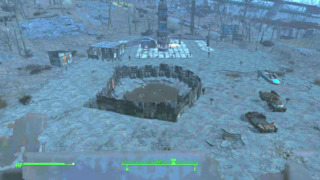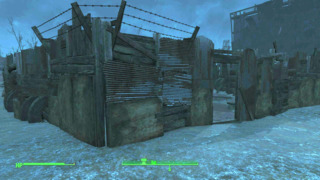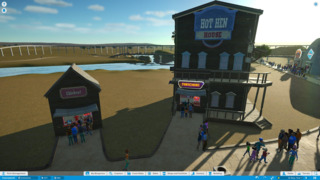
How much time, would you say, is too much time trying to perfectly place a fence in Fallout 4? A minute? Maybe five minutes? Maybe 10? I think I’ve spent at least an hour just trying to place fences in Fallout 4.
This is, admittedly, not a problem most people will have. I’m a bit of a perfectionist, and in Fallout 4, I found myself getting strangely invested in the state of the settlements. This meant that whenever the game asked me to engage in its base-building subgame to progress some quest, I felt compelled to stop what I was doing and make sure the settlement was functional and attractive.
For instance, I spent a whole 30 minutes of my life making sure the radioactive pit in the middle of a parking lot was properly fenced out. Granted, being this invested in it was my fault. But, if we’re being honest, it was also the game’s fault that it took me this long.
The only tall fence available in Fallout 4, the “junk fence,” doesn’t snap-fit together like some of the game’s other base-building objects. Rather, you place it freely in space by pointing somewhere. Free object placement doesn’t really work as a mechanic; it’s almost a user interface cop-out. Between Fallout 4 and Planet Coaster, I’ve seen pretty clearly that it’s the wrong way to implement building mechanics in a game. Planet Coaster goes even further and gives you tools to place props in 3D space that are really more like level design tools than like a game mechanic, down to handles for translation and rotation in space.
Building stuff is inherently playful, and it has been explored mechanically in countless games. Yet it’s so easy to get wrong, and it illustrates very well how adding complexity is usually not the solution.
Before 3D engines were commonplace and flexible enough to allow this sort of thing, most games that let you build things (usually games entirely about building--tycoon games, sims) used a tiled map where you would place down objects like blocks. This is the most noticeable change from Rollercoaster Tycoon to Planet Coaster: You are no longer constrained by the square grid of the older games. Removing this restriction turns out to make the game worse.
In the shift from the discrete world of tiles and blocks, to the analog world of points in space, possibilities multiply and the ability to judge correctness dwindles. Planet Coaster does include some amount of grid-based handholding, but it’s clear (from the pre-made buildings included with the game if nothing else) that you’re not really supposed to rely entirely on it. Besides, Planet Coaster’s grids are all relative, individual to each particular building. This makes it painful to integrate one building with another, say if you want them to be connected by paths or ride tracks. Without the global tile grid that Rollercoaster Tycoon was built on, fitting things together often fails.

In Fallout 4, the fact that you’re building using jagged objects made of cobbled-together junk really highlights this; as a rule, the colliders are somewhat oversized, meaning that things don’t fit together neatly unless they snap together; they always leave a gap. And while the structural parts of the building set do snap together like legos, they don’t do so predictably or reliably; you can’t tell from looking at two pieces whether they’ll connect, and when they do connect, whether the connection will make sense visually as well. Things often fail to connect because of unseen object collisions; in one case, I found that the game would let me do something that clearly should have been possible, but only if I placed the pieces in a specific order. Go into Fallout 4, and pick up the set of wire fences that the game provides. They snap together, but I dare you to fence off a square area with them without leaving gaps. Surprise: They don’t actually all fit in the same grid, and there’s no interface indication of this when you’re placing them.
If these seem like nitpicks, they are. The whole endeavor is nitpicky. Planet Coaster expects you to build a custom building around ride tracks to serve as the ride station, for example, but there are no affordances to make sure the height of the tracks conforms to the height of the standard building blocks. The footpaths that guests use to get around in the park can’t be saved along with building blueprints, meaning that buildings that integrate with paths (say, a castle that guests can walk up on the parapets of) is dicey. I find that Planet Coaster is really good at breaking up the creative flow of building something--something doesn’t fit together, something doesn’t work, and suddenly the magic is gone and I feel silly for spending my time this way.
Compare that to how The Sims does it: Newer iterations of the franchise have never gotten away from its tile-based system for building houses. A Sims home is inevitably built on a grid. This means that there are some architectural features that can’t be achieved at all--you can never have a round room like a McMansion turret, for instance. But what you lose there isn’t much compared to what you gain: Building houses in The Sims is a joy, and for many players it’s the best part of the game. You can’t make a hallway that is three and a half tiles wide or build on multiple split levels, but there is just enough there to make it satisfying. It’s still possible to build architectural trainwrecks, but it doesn’t take hours of fiddling to get something that looks good.
Granted, Planet Coaster’s problem isn’t really a problem at all for the people who enjoy the niche activity of designing content for that game. It curtails the game’s audience in some ways, but there is no sin in being niche. Players have definitely built very impressive creations using the in-game tools; but while they don’t lack power, they’re a missed opportunity because they don’t scale. Well-designed building games, like The Sims and Minecraft, have a scaling quality to them; there’s not much of a barrier to creating something satisfying. Minecraft achieves this smartly by using the limited resolution of its blocks. To make something detailed and complex, you have to make it huge. Small creations are inherently going to be simpler and easier to put together. Like on The Sims, the buildings that come with the game are created using the same tools that players use, they’re achievable.
In Planet Coaster, the example content is seemingly the product of hours of mystifying tinkering. It’s an all-or-nothing proposition; the interface, the tools, and the preexisting content seem to suggest: do it right, or not at all. It’s like a model kit, in contrast to the Lego ethos of there is no wrong way to do it. And many people have built impressive things with Planet Coaster, perhaps more impressive than what you can build with tools geared less towards such invested players. But model kits are a niche hobby, while Legos are the best-selling toy line of all time. It feels like a missed opportunity when Planet Coaster’s predecessor, Rollercoaster Tycoon, was so much more accessible without sacrificing the complexity that made that series special.

Fallout 4, however, definitely has problems: the tools are nowhere refined or powerful enough to be like level editing tools, but they still suffer from fiddliness. If Planet Coaster saddens me even though I know it makes a lot of players very happy, I can’t imagine anyone really loves the base-building subgame in Fallout 4. Even using the snap-fit objects is an unpleasant experience: In a miserable design decision, you are expected to choose which specific variation of a garbage shack wall you’re going to use in each place, instead of simply putting down interchangeable pieces that look different each time. This makes the building menus about as lengthy and time-consuming to navigate as the actual mesh catalog in a level editor, except that to actually place them, you roughly look in some direction and the game tries to guess where you mean to place them. Usually, it guesses wrong, forcing the player to reposition things until they snap into place.
The broader problem is losing sight of why a given game’s built environment fascinates in the first place. Rollercoaster Tycoon was built around the premise that your park guests are an active and opinionated audience, and you are building rides to please their tastes. In Planet Coaster, a lot of attention is given to building tools that don’t really matter; the quality of the buildings you’re making is in no way judged. Guests, at most, react only to the sheer volume of scenery around them. This isn’t to say simulating some kind of aesthetic AI that would judge how good buildings are would be easy; it would be nigh impossible. That’s a reason not to make the building features too detailed, right there. My Planet Coaster creations will never really be appreciated by anyone unless I make them good enough (and thus, time-consuming enough) to be interesting to other human players. At the same time, the process of building them is lengthy and unpleasant enough that I don’t even get individual satisfaction out of it.
In Fallout 4, the idea of cobbling things together from available materials and building on top of the ruins of the pre-war past is right there for the taking, but the actual mechanics totally bypass it. Early in the game, you might encounter a farmhouse built around the structure of an old transmission tower. You can never do anything like that yourself. I spent several minutes trying to place blocks so it would look like I had added a wooden lean-to onto the steel skeleton of a pre-war suburban home, and failed.
Compare this to a game that has a similar 3D environment but does base-building better: Subnautica. In that game, all structural base parts connect together smoothly like legos, with results that are both visually and mechanically appealing. When you place them, the game generates struts to connect the building to the terrain in ways that make sense, helping integrate your base to the surrounding ground. It’s hard to overstate how important that small visual detail is: your bases look like they belong where they are. Because bases are always lifted on stilts, they don’t have to deal with the uneven terrain. You never get a weirdly floating, seemingly unsupported chunk of building that spoils the illusion.

And tinkering is its own form of fun, but it requires malleability. What really breaks flow in any building game is having to backtrack something I did previously to support something I’m doing next. In Sims games, every step of construction is discrete, and minimal planning is necessary. You don’t have to think about where the windows will go when you’re placing walls. So an easy workflow emerges where you place each thing one at a time, with little backtracking or revision of previous steps. This isn’t very representative of what an actual design process is like, but in the same fun way that DOOM isn’t representative of what being a soldier is like. It’s fun in the way Planet Coaster isn’t, for me: the core experience of Planet Coaster is launching the game, opening up a park, starting work on building something, hitting an unpleasant hitch that would make me backtrack a bunch, and deciding to quit the game instead.
Building mechanics walk this tightrope: Building things is inherently interesting, inherently fun. But it’s very easy to break the spell; it rests less on the question of how to make the mechanics fun, and more on how to refine them to sustain the play value of the thing. And, as often seems to be the case, more complexity and more options doesn’t improve the experience. Legos are by far the most popular toy in history, much more enduring than other building toys, precisely because they fit together in such limited and constrained ways. There’s no wrong way to fit two Lego blocks together, and that lack of judgment is essential to joy.